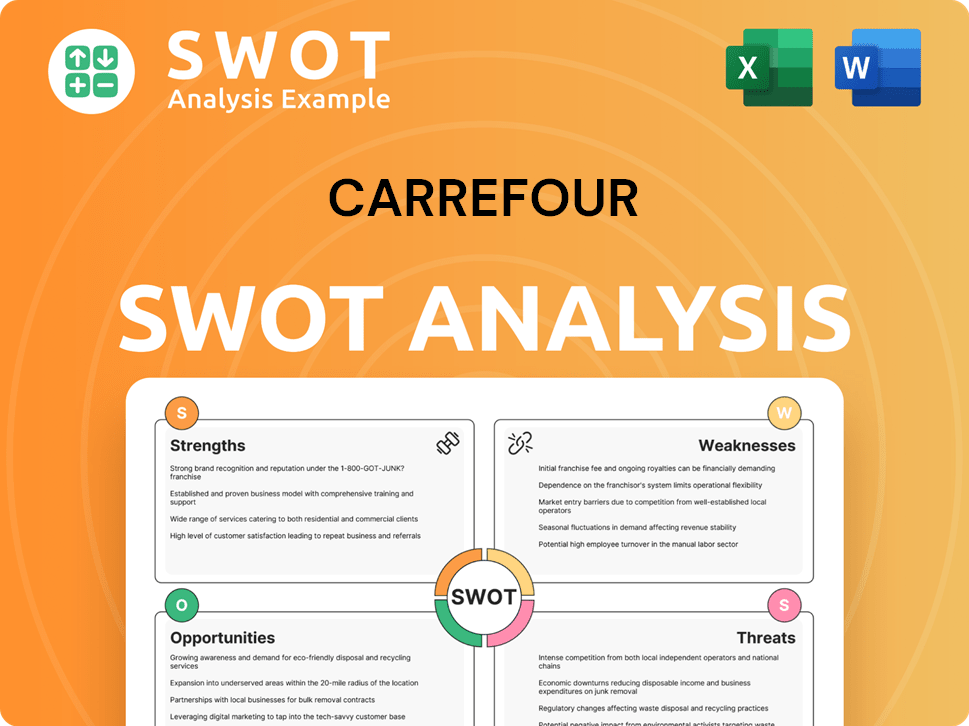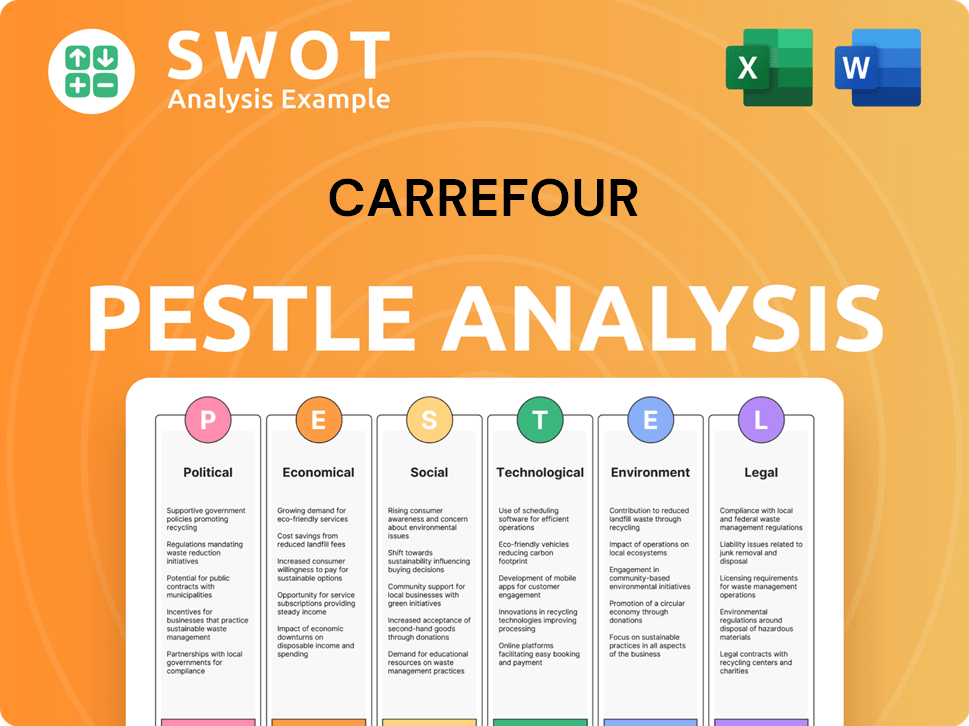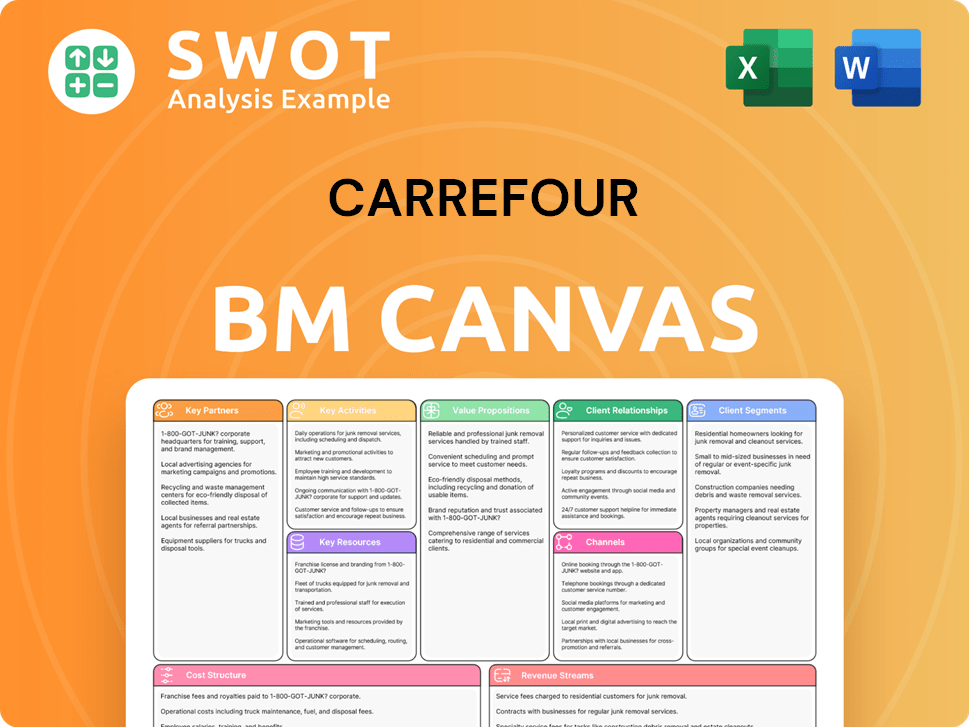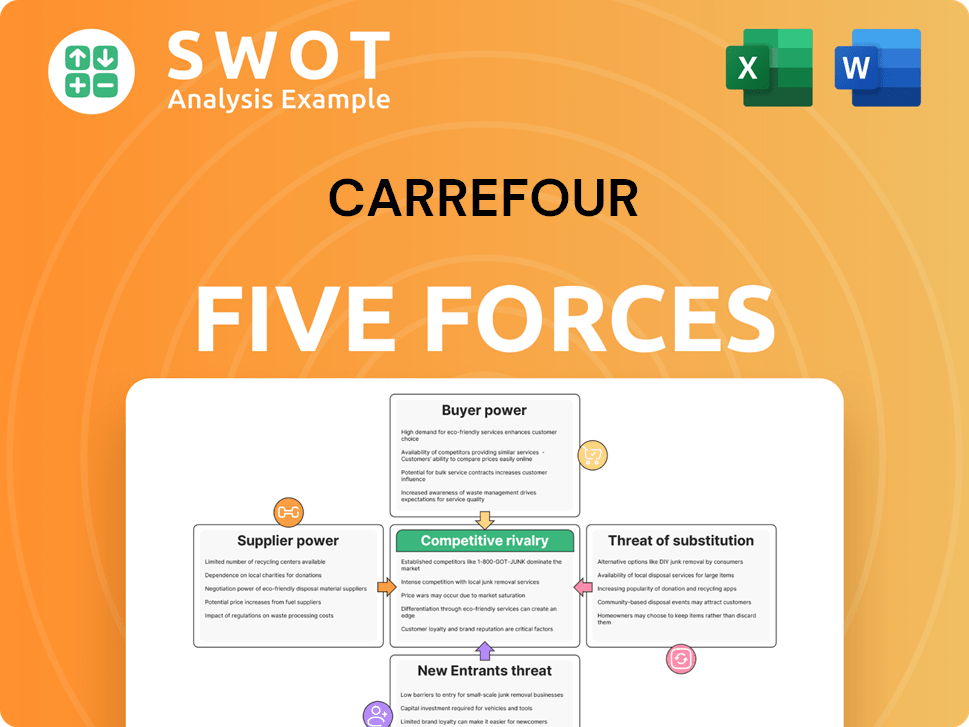Carrefour Bundle
Decoding Carrefour: Who Are Its Customers?
In today's dynamic retail industry, understanding customer demographics and pinpointing the target market is crucial for any business aiming for longevity. For Carrefour company, a global retail leader, adapting to evolving consumer behavior is essential for maintaining its competitive edge. This analysis dives deep into Carrefour's customer profile, exploring its market segmentation strategies and the factors driving its success.

From its humble beginnings to its current status as a multinational corporation, Carrefour's ability to adapt to changing consumer needs has been remarkable. This exploration will provide insights into Carrefour's customer demographics across various geographic locations, including France, Spain, and Brazil, and analyze their buying habits. Discover how Carrefour leverages Carrefour SWOT Analysis to refine its marketing strategies and maintain its competitive advantage in the retail industry, focusing on its target market.
Who Are Carrefour’s Main Customers?
Understanding the primary customer segments is crucial for the success of the Carrefour company. The company primarily focuses on Business-to-Consumer (B2C) clients, with a smaller presence in the Business-to-Business (B2B) sector through its cash and carry outlets. This customer base is diverse, spanning various demographics and shopping behaviors across its global operations.
The core of Carrefour's customer base includes individual consumers and households. The customer demographics vary significantly depending on the geographic location. Common characteristics include middle-income families, urban and suburban dwellers, and individuals seeking a wide array of products. These products range from everyday groceries to household goods and electronics, all offered at competitive prices.
Carrefour's market segmentation strategy is designed to cater to different shopping needs and demographic profiles. The company operates various store formats, including hypermarkets, supermarkets, and convenience stores. Hypermarkets typically attract families doing large weekly shops, while convenience stores serve urban dwellers looking for quick purchases.
In Europe, particularly in France, Spain, and Italy, Carrefour's customer base often consists of established households. They tend to have a preference for fresh produce and private-label goods. In emerging markets like Brazil and Argentina, the customer demographic might be younger. They place a greater emphasis on value and convenience.
Carrefour's different store formats cater to various shopping missions. Hypermarkets are designed for large weekly shops, while convenience stores cater to quick purchases. The company's private label products, which saw a 16% increase in sales in 2023, appeal to value-conscious consumers across different segments.
The growth of e-commerce has increased the focus on tech-savvy consumers. They prioritize convenience and online delivery options. The company aims to reach 8 billion euros in organic product sales by 2026. Carrefour's loyalty program, 'Carrefour & Moi,' with 15 million active members in France, helps understand and target customer preferences.
The 'Carrefour & Moi' program allows for personalized promotions and offers. The expansion into financial services targets customers seeking integrated retail and financial solutions. Carrefour's e-commerce food sales grew by 26% in 2023, indicating a shift towards online shopping.
Carrefour's primary customer segments are diverse, including middle-income families, urban dwellers, and value-conscious consumers. The company's market segmentation strategy involves various store formats and private label products. E-commerce and health-conscious consumers are becoming increasingly important.
- Middle-income families seeking a wide range of products.
- Urban and suburban dwellers looking for convenience.
- Value-conscious consumers, especially those interested in private-label goods.
- Tech-savvy consumers who prefer online shopping and delivery.
Carrefour SWOT Analysis
- Complete SWOT Breakdown
- Fully Customizable
- Editable in Excel & Word
- Professional Formatting
- Investor-Ready Format

What Do Carrefour’s Customers Want?
Understanding the customer needs and preferences is crucial for the success of the Growth Strategy of Carrefour. These needs are diverse, covering practical, psychological, and aspirational aspects that drive consumer behavior. The company tailors its offerings to meet these varied demands, ensuring customer satisfaction and loyalty within the competitive retail industry.
Customers of the company seek a combination of quality products, competitive pricing, and convenient shopping experiences. This includes a wide product range, from groceries to non-food items, available in various store formats. The company also focuses on addressing customer pain points such as efficient checkout processes and readily available stock, enhancing the overall shopping experience.
Psychological factors, such as convenience and time-saving, are also important. This is particularly true for busy urban consumers who increasingly use online shopping and click-and-collect services. Aspirational drivers, such as the demand for healthier and sustainably sourced products, are also significant. The company responds by expanding its organic food offerings and promoting sustainable initiatives.
Customers prioritize access to a wide range of products at competitive prices. This is addressed through the extensive product assortment and various store formats offered by the company.
Busy consumers value convenience, leading to increased demand for online shopping and click-and-collect services. The company invests in digital transformation to improve the online shopping experience.
There is a growing demand for healthier, organic, and sustainably sourced products. The company responds by expanding its organic food offerings and promoting sustainable initiatives.
Private label products, which accounted for 36% of food sales in 2023, resonate with customers seeking value and quality. These products offer a cost-effective alternative without compromising on quality.
Customers expect efficient checkout processes, readily available stock, and clear product information. The company addresses these needs through operational improvements and digital enhancements.
The company invests in digital transformation, including its e-commerce platforms and mobile applications, to improve the online shopping experience and cater to the preference for digital interaction.
The company employs several strategies to meet customer needs and preferences. These include expanding product offerings, improving the shopping experience, and promoting sustainability.
- Product Expansion: Broadening the range of products to include organic and sustainable options.
- Digital Transformation: Enhancing e-commerce platforms and mobile applications for better online shopping.
- Sustainability Programs: Implementing initiatives like the 'Act for Food' program to address consumer concerns about food quality and sustainability. The company aims to have 100% of its own-brand fresh produce from sustainable sources by 2026.
- Private Labels: Offering value and quality through private label products, which account for a significant portion of sales.
Carrefour PESTLE Analysis
- Covers All 6 PESTLE Categories
- No Research Needed – Save Hours of Work
- Built by Experts, Trusted by Consultants
- Instant Download, Ready to Use
- 100% Editable, Fully Customizable

Where does Carrefour operate?
The geographical market presence of the Carrefour company is extensive, with a significant footprint across multiple continents. Its strongest presence is in Europe, where it has established a robust network of stores, particularly in countries like France, Spain, Italy, and Belgium. This widespread presence allows Carrefour to cater to diverse customer demographics and buying habits across various regions.
France serves as Carrefour's largest market, boasting a comprehensive retail network and a substantial market share. Beyond Europe, Carrefour has a notable presence in Latin America, especially in Brazil and Argentina, where it has become a leading retailer. These strategic locations demonstrate Carrefour's commitment to adapting its operations to meet the specific needs of each market.
Carrefour's geographical strategy involves significant localization efforts to cater to the varying customer demographics, preferences, and buying power in each region. This approach is crucial for effectively targeting the Carrefour target market and optimizing its market segmentation strategy. The company continuously adjusts its strategies, as seen by its strategic withdrawals and expansions in different markets.
Europe is a key market for Carrefour, especially in France, where sales reached €42.3 billion in 2023. The company focuses on optimizing existing store formats and enhancing its private label offerings to cater to mature markets. This includes converting hypermarkets into smaller formats and focusing on proximity stores to meet changing consumer needs.
Latin America, particularly Brazil, represents a significant growth area for Carrefour. In 2023, sales in Brazil reached €24.7 billion, making it the second-largest market. The company emphasizes value and bulk purchasing options to cater to the consumer base, adapting its marketing and product offerings to local tastes.
Carrefour tailors its strategies to suit the local market conditions. In Europe, the focus is on optimizing existing store formats and enhancing private label offerings. In Latin America, Carrefour emphasizes value and bulk purchasing options.
Carrefour continues to invest in e-commerce infrastructure globally to enhance its omnichannel retail experiences. This reflects a dynamic approach to optimizing its geographic distribution of sales and growth based on market potential and profitability.
The acquisition of Grupo BIG in Brazil in 2022 further solidified Carrefour's position in the key market. This demonstrates a commitment to strategic growth in high-potential regions and a proactive approach to expanding its market share.
Carrefour adapts its marketing campaigns, product assortments, and store layouts to resonate with local cultures and consumer behaviors. This includes offering region-specific fresh produce and local brands to cater to diverse consumer preferences.
Recent strategic withdrawals from certain markets, such as China in 2019, reflect a dynamic approach to optimizing its geographic distribution of sales and growth based on market potential and profitability. This shows a willingness to adapt to changing market dynamics.
In France, Carrefour has been converting some hypermarkets into smaller formats and focusing on proximity stores to cater to changing urban shopping habits. This shows a response to evolving lifestyles and shopping preferences.
Carrefour Business Model Canvas
- Complete 9-Block Business Model Canvas
- Effortlessly Communicate Your Business Strategy
- Investor-Ready BMC Format
- 100% Editable and Customizable
- Clear and Structured Layout

How Does Carrefour Win & Keep Customers?
The [Company Name] employs a comprehensive strategy for acquiring and retaining customers, utilizing a blend of traditional and digital marketing channels. This approach is supported by robust loyalty programs and personalized customer experiences. The company focuses on attracting new customers through extensive advertising campaigns across various media and digital platforms.
Customer retention is a key focus, with loyalty programs playing a crucial role in fostering repeat business. These programs offer personalized discounts, exclusive promotions, and reward points. The company uses customer data to tailor marketing efforts, product recommendations, and personalized offers, enhancing the overall customer experience.
The company's strategy involves a shift towards digital engagement and personalization to meet changing consumer preferences. This approach aims to increase customer lifetime value and decrease churn rates by creating more engaging experiences. The company's initiatives are designed to build trust and align with evolving consumer values.
Advertising campaigns are conducted across television, radio, and print media. Digital platforms like social media (Facebook, Instagram, TikTok) and search engine marketing are also used. Targeted online ads and influencer collaborations help reach specific customer demographics.
E-commerce platforms are central to acquiring new customers who prefer online shopping and home delivery. The company invests in user-friendly interfaces and efficient logistics. In 2023, the company's e-commerce food sales grew by 26%, indicating the success of its digital acquisition efforts.
Promotional offers, discounts, and introductory bundles are frequently used to attract first-time shoppers. This strategy helps to quickly expand the customer base. These offers provide immediate value and encourage trial purchases.
Loyalty programs like 'Carrefour & Moi' in France, which had 15 million active members in 2023, are crucial. These programs offer personalized discounts, exclusive promotions, and points for future purchases. This fosters repeat business and customer loyalty.
The company's strategy involves leveraging customer data to tailor marketing campaigns, product recommendations, and personalized offers. CRM systems are used to manage customer interactions and provide targeted communications. Enhancing in-store and online customer experience through improved service and efficient checkout processes is also a priority. The 'Act for Food' initiative builds trust and aligns with consumer values. The company has shifted its strategy to place a greater emphasis on digital engagement and personalization. This shift aims to increase customer lifetime value and reduce churn rates.
The company uses a multi-faceted approach to acquire and retain customers. This includes a focus on digital marketing and personalized experiences. Customer data is used to segment the customer base and tailor marketing efforts.
- Extensive advertising campaigns across various media.
- E-commerce platforms with user-friendly interfaces and efficient logistics.
- Promotional offers, discounts, and introductory bundles.
- Loyalty programs offering personalized rewards.
- Enhancement of in-store and online customer experience.
- Emphasis on quality, fresh, and sustainable products through 'Act for Food'.
Carrefour Porter's Five Forces Analysis
- Covers All 5 Competitive Forces in Detail
- Structured for Consultants, Students, and Founders
- 100% Editable in Microsoft Word & Excel
- Instant Digital Download – Use Immediately
- Compatible with Mac & PC – Fully Unlocked

Related Blogs
- What are Mission Vision & Core Values of Carrefour Company?
- What is Competitive Landscape of Carrefour Company?
- What is Growth Strategy and Future Prospects of Carrefour Company?
- How Does Carrefour Company Work?
- What is Sales and Marketing Strategy of Carrefour Company?
- What is Brief History of Carrefour Company?
- Who Owns Carrefour Company?
Disclaimer
All information, articles, and product details provided on this website are for general informational and educational purposes only. We do not claim any ownership over, nor do we intend to infringe upon, any trademarks, copyrights, logos, brand names, or other intellectual property mentioned or depicted on this site. Such intellectual property remains the property of its respective owners, and any references here are made solely for identification or informational purposes, without implying any affiliation, endorsement, or partnership.
We make no representations or warranties, express or implied, regarding the accuracy, completeness, or suitability of any content or products presented. Nothing on this website should be construed as legal, tax, investment, financial, medical, or other professional advice. In addition, no part of this site—including articles or product references—constitutes a solicitation, recommendation, endorsement, advertisement, or offer to buy or sell any securities, franchises, or other financial instruments, particularly in jurisdictions where such activity would be unlawful.
All content is of a general nature and may not address the specific circumstances of any individual or entity. It is not a substitute for professional advice or services. Any actions you take based on the information provided here are strictly at your own risk. You accept full responsibility for any decisions or outcomes arising from your use of this website and agree to release us from any liability in connection with your use of, or reliance upon, the content or products found herein.